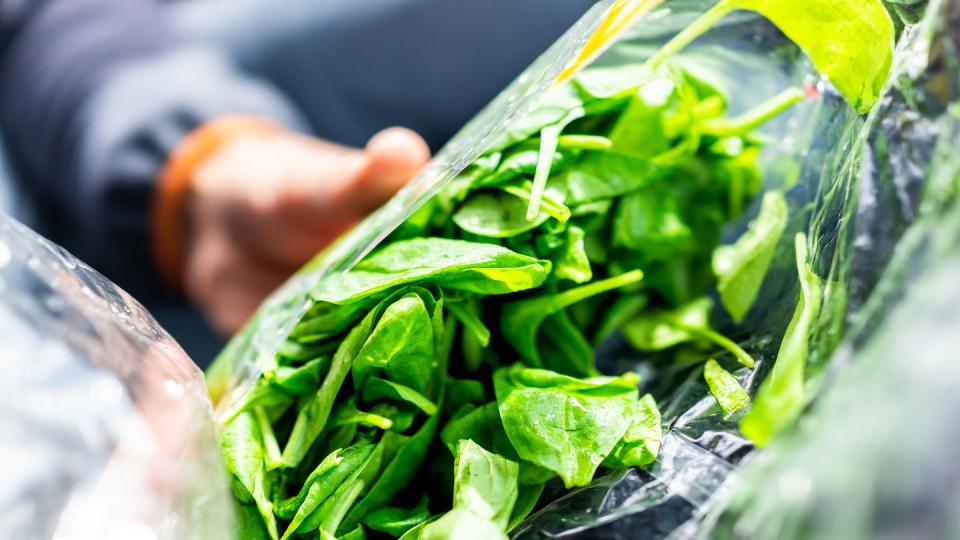After Watching Netflix's 'Poisoned," Here's How to Protect Yourself From Foodborne Illnesses

If you’ve ever stepped away from a food truck with stomach cramps or had flu-like symptoms after a big family barbecue, you’ve probably had food poisoning — and you’re far from alone.
Thanks to the new Netflix doc, Poisoned: The Dirty Truth About Your Food, everyone is buzzing about the pervasiveness of foodborne illness, and potential dangers lurking in our restaurants and grocery stores. The Federal government estimates that there are about 48 million cases of foodborne illness annually. That’s the equivalent of one in six Americans every year. But the true number of people who experience food poisoning could be even higher.
“Cases of foodborne illness are vastly underreported,” says Dr. Elliot Ryser, PhD, a professor of food science and human nutrition at Michigan State University. That’s because for some people the symptoms are mild, can be easily confused with a flu or other virus, and because it can sometimes take days for people to actually get sick after downing a bad burrito from a fast-food chain or bringing home contaminated chicken from the market. All of this can make it tricky for someone to pinpoint what made them ill.
What is a foodborne illness?
A foodborne illness (also called food poisoning) is an infection caused by eating foods that contain harmful microbes in them. While some germs on in our food can harm us, there are thousands of different types of bacteria naturally present all around us and not all bacteria are bad. The types used in making cheese, yogurt and sourdough bread, for example, can be beneficial. Plus, many types of microorganisms don’t affect us at all. But, certain strains of bacteria, and viruses, can contaminate our fresh produce, seafood, raw meats and eggs, that are used at a restaurant, or that we bring home from the market, causing foodborne illness. There are more than 250 foodborne illnesses, but the top five are probably ones you’ve already heard of: norovirus, salmonella, campylobacter, clostridium perfingens (which causes botulism) and staphylococcus.
Signs of a foodborne illness can emerge in as little as a few hours after eating something suspect, but it often takes several days, or even a few weeks for symptoms to emerge. “People often mistakenly think it’s the last thing they ate, but it could have been something from a few days before,” says Dr. Ryser. If you eat lettuce laced with E. coli, you’ll likely feel ill within three to four days, while a deli sandwich containing listeria might not make you sick for two weeks, for example.
Are foodborne illnesses dangerous?
Anyone who nibbles on a chunk of contaminated cantaloupe or who handles raw chicken where disease-causing microbes are present are at risk of getting sick. Symptoms can range from a mild stomach ache, to unpleasant flu-like symptoms, including diarrhea and fever, to serious disease outcomes like jaundice and respiratory failure.
“In the vast majority of cases, people do recover on their own within a few days, without treatment,” says Dr. Ryser. But for some, food poisoning can be quite serious. People who are at risk of more severe illness and potentially deadly complications include babies, the elderly and those with compromised immune systems. Foodborne illnesses result in an estimated 128,000 hospitalizations – and 3,000 deaths – every year.
There are also some emerging strains of bacteria that may be causing more serious and widespread illness. The CDC recently identified a new strain of E. coli, known as REPEXH02, linked to romaine lettuce and other leafy greens. It is suspected to be responsible for multiple major outbreaks of foodborne illness across the country in recent years, that have resulted in dozens of hospitalizations and numerous cases of hemolytic uremic syndrome (HUS), a rare but serious disease that affects red blood cell function and can cause kidney failure.
The major causes of foodborne illness
Campylobacter is one of the most common culprits and the number one cause of bacterial-related diarrheal illness in the United States. According to the Foodborne Diseases Active Surveillance Network (FoodNet), there are about 20 cases for every 100,000 people every year. These infections are often traced back to eating undercooked poultry – or something that touched it. Campylobacter can be spread easily through food handling, like when a cutting board is used to prepare raw chicken and isn’t properly washed before it's used to chop vegetables, for example. E.coli has been found in a wide range of foods from baby spinach to fresh cut fruits. Listeria contamination has been behind many recalls of deli meats. And salmonella may be associated with undercooked chicken, but it can also be found in dry goods. “Now we have a lot of concern about salmonella in low moisture packaged foods like flour,” says Dr. Ryser.

There are several viruses that cause foodborne illness, too. “Norovirus is responsible for an estimated two thirds of all cases,” says Dr. Ryser. It’s best known for its typical first symptom: projectile vomiting. In the United States, norovirus is the most common cause of illness from contaminated food or water, and the virus you are most likely to encounter in a bag of salad greens from the grocery store, or at an oyster bar.
Common foods related to foodborne illness
“Sprouts are probably one of the one of the riskiest products in the produce section,” says Dr. Ryser. Pea, broccoli and bean sprouts are grown in the perfect conditions for bacteria to multiply, so they are often contaminated, he says. “That’s one item I tend to avoid.”
Bags of so-called “pre-washed” lettuce and other greens can be rife with both bacterial and viral contamination, says Ryser. The deli aisle is another area of the supermarket where you are more likely to find foods containing microbes. This is often due to the food handling process, where cutting boards and meat slicing machines can all too easily spread contamination around.
What you should do if you suspect you have a foodborne illness
Symptoms of food poisoning could start anywhere from a few hours, to even a few weeks, after stopping at a restaurant for a hamburger, or cooking with contaminated chicken. The most common symptoms are diarrhea, stomach pain, nausea, vomiting and fever.
Often, getting lots of rest and drinking plenty of fluids (particularly if you have diarrhea and/or vomiting and are at risk of dehydration) are sufficient to help you recover. But if you have a fever higher than 102°F, diarrhea that is bloody or lasts more than three days, or vomiting so severe that you can’t keep fluids down, call your doctor. These are signs of severe food poisoning, and you should receive medical attention. Some infections can lead to other health problems including meningitis, nerve damage and kidney damage, so it’s best to take every precaution.
Preventing foodborne illness
One of the best ways to protect yourself is to take care while prepping your meals at home. To reduce your risk of food contamination you should:
Use separate cutting boards for raw meats and produce
Wash your hands well before and after handling food
Opt for whole produce (not pre-sliced), and wash it well
Do not rinse your poultry in the sink before you cook it (since this just spreads possible bacteria around your sink)
Be diligent about keeping foods that require refrigeration cold (because if your lettuce is contaminated with salmonella or E. coli from the supermarket, those types of bacteria will multiply quickly at room temperature)
Use a meat thermometer and ensure ground beef and poultry are cooked to an internal temperature of 160°F
It’s also important to stay alert about CDC outbreak notices and food safety recalls. But it’s worth noting that while investigators and retailers work quickly to remove contaminated foods from restaurants and store shelves, it can take three to four weeks from the day someone eats a contaminated food to the day their illness can be linked to an outbreak.
You Might Also Like

